Wild inflation, the world seemingly coming to an end, Patek Philippe determined to build a new signature sports watch — this was the Fall of 1999. It was the end of the millennium, the Graves watch sold for (a mere) 11 USD million at auction, the Twenty-4 was the best-selling Patek Philippe of all time (still is), and the world was anxiously waiting for Y2K. Bill Clinton was acquitted for obstruction of justice and Trump was noodling a run for the presidency and considering Oprah Winfrey as a running mate. Indeed, simpler times.
It was also the time of the Russian financial crisis that resulted in the severe devaluation of the ruble and near economic collapse — inflation in the country reached 84% and countless banks closed permanently. Russia was on the verge of yet another major historical shift – and Patek Philippe was the talk of the town.
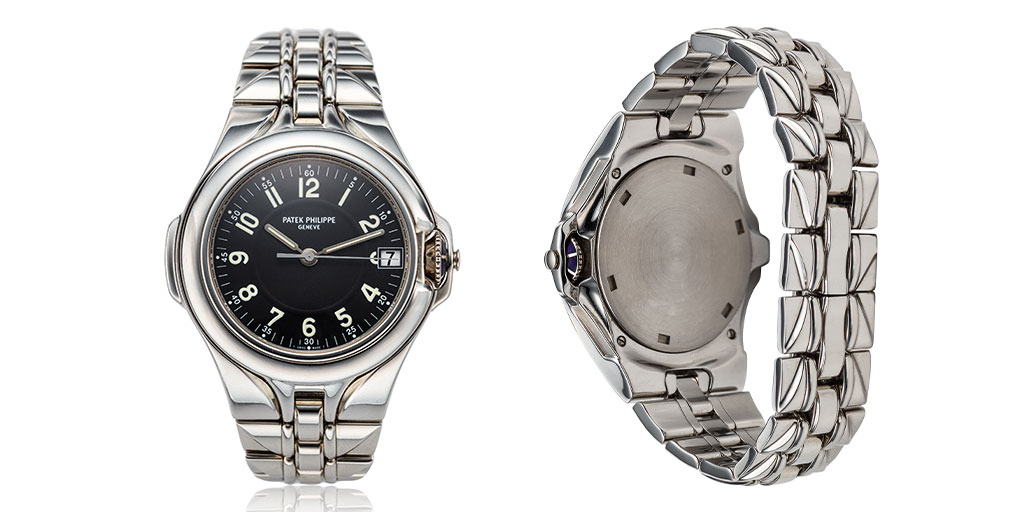
In late 1999, a lavish party hosted by Patek Philippe, and the Russian distributor was held at the State Historical Museum in Red Square. It was the first time in history that Red Square was closed for a commercial event. Over 600 guests arrived by limo and drove up to the museum for a true red carpet event and were treated to a lavish night of extravagance and the introduction of a Patek Philippe limited edition made especially for the Russian market: The Sculpture. Also, on view that evening were pocket watches of exceptional historical importance from the Patek Philippe Museum collection, including Patek Philippe watches that belonged to Lev Nikolayevich Tolstoy, Pyotr Ilyich Tchaikovsky, as well as Albert Einstein, Marie Curie, and of course, Queen Victoria’s pendant watch.
The Patek Philippe Scuplture collection was made especially for the Russian market in celebration of five years of business with the Russian distributor Mercury Group. Today it seems amazing that Patek Philippe would celebrate such a short anniversary with a limited edition, but the deep roots of Patek Philippe selling to the Russian market is intertwined into the earliest years of the company’s history. Notably, the Mercury Group was named after the Roman god of commerce, also the god of communication, travel, and financial gain. The Mercury Group spearheaded the distribution of countless luxury brands into Russia including Gucci, Prada, Dolce & Gabbana, as well as almost all the major Swiss watchmaking houses, including Patek Philippe. Later, Mercury distributed car makers such as Ferrari and Maserati, and in 2008, Mercury acquired what is now known as Phillips auction house.
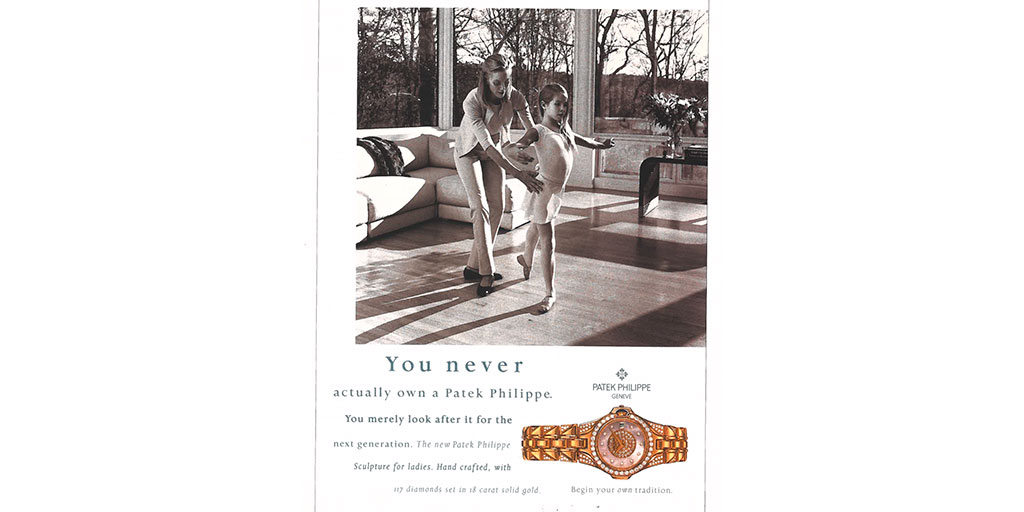
All that said, let’s go back to the watch. The Sculpture was introduced with a total of 2,700 examples in approximately a dozen different executions with the promise that no more than 300 examples would be made in each design. The basic design was inspired by the Nautilus and was an attempt to modernize the aesthetic with a look that paid homage to all things Patek Philippe with a Russian twist. At first, the collection was uniquely available to the Russian market and later distributed around the world. The strategic intention was to offer a six-month exclusive to the Russian market, and then release the collection to the world via authorized retailers.
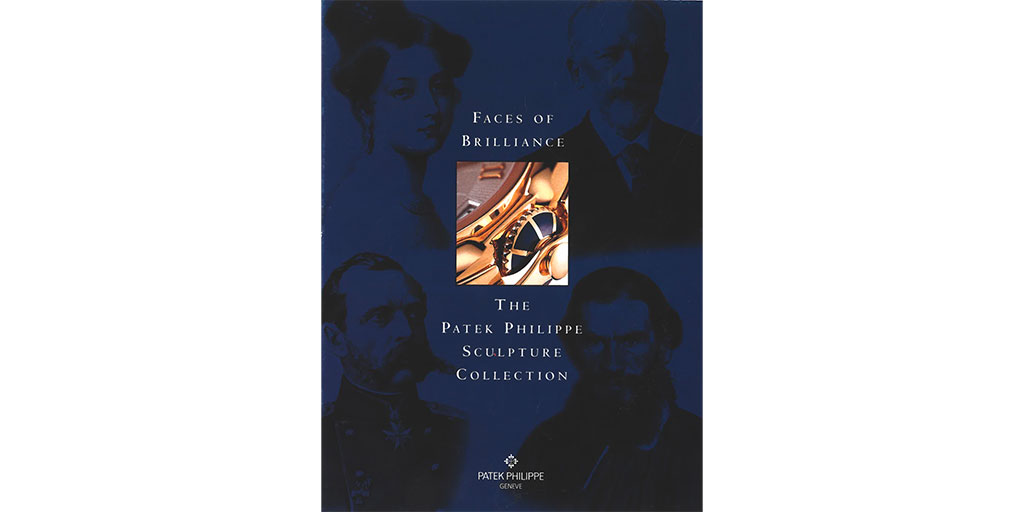
According to a brochure titled ‘Faces of Brilliance’ from the year 2000, published to introduce the Sculpture to the global market, the marketing machine pitched the collection to a wider audience: “Here we welcome you to the Patek Philippe Sculpture collection, a new and desirable range of sports watches drawing on the rich decoration traditions of Continental Europe … The Sculpture Collection of sports watches evokes a very contemporary blend of strength and sensuality – evident in the smooth, sculpted lines of the case and softness of the polished metal.”
Within this brochure it is interesting to note that some of the ladies’ watches featured Top Wesselton diamonds were “sourced from South Africa and Russia”.

The Sculpture Case
The basic design of the Sculpture collection has a smooth, rounded bezel that is fully integrated into the bracelet models. The bracelet models feature a look that had not been seen in the watch world before, a surprising departure for a brand often considered traditional and conservative. The bracelet features central, rectangular links that are chamfered and rounded, while the respective side links are squared with a ridge that bisects each link. It is a homage to geometry that looks simple but is actually quite complex on closer inspection. Look at the design of the Imperial crown of Russia and the influence of Russian design on this bracelet is clearly not a coincidence. The strap models feature thick, stylized lugs that were distinctly different from the classic Calatrava lugs.
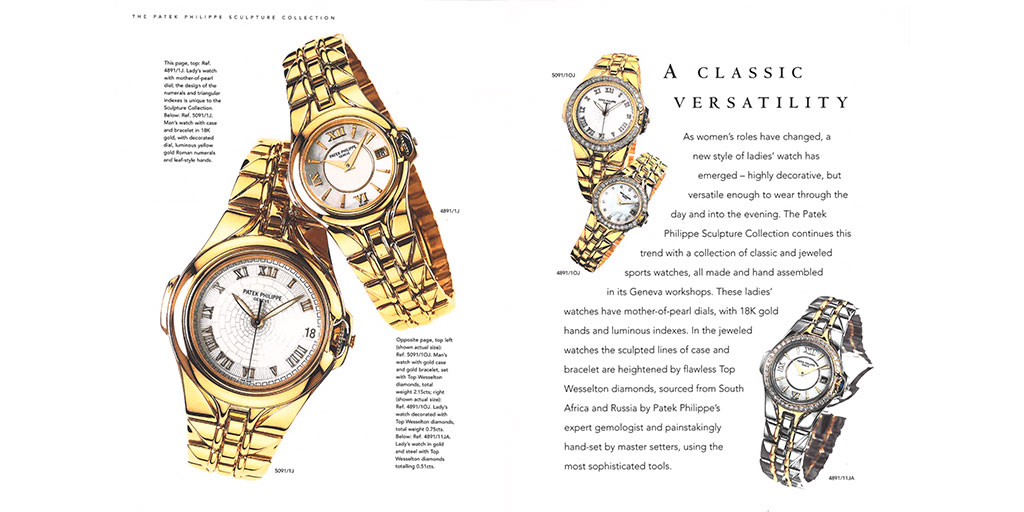
The most surprising design element that distinguishes the Sculpture collection is the enameled Imperial blue crown that is protected and “perfectly integrated with the softly sculpted lines of the case.” A close inspection of the blue enamel crown is reminiscent of a Faberge egg or maybe even a nod to the classic architecture of Russia. It is a design element that we have never seen from Patek Philippe before and will likely never see again.
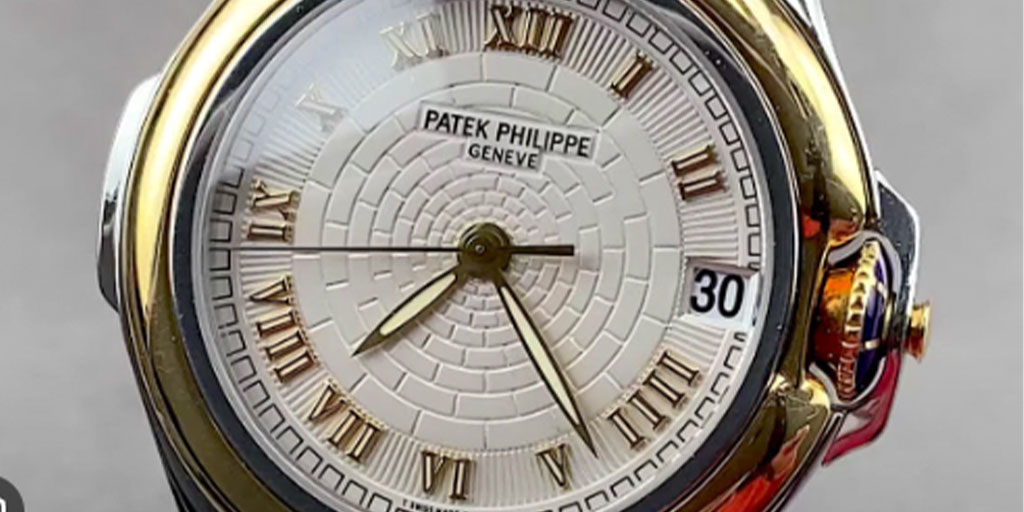
The Sculpture Dials
The attention given to the design of the dials of the Sculpture collection is quite impressive. Starting with the ladies’ references, we see exquisite mother-of-pearl examples some featuring applied roman numerals and others with applied diamond markers. With the men’s examples, we see a wide variety of offerings but the most surprising is the ‘brick’ dial of the ref. 5090J and ref. 5091/1J. At the time, it was the most sumptuous and complex men’s dials made by Patek Philippe. On close inspection, it’s also a geometric study into the proportions of the Golden Section with the concentric brick links. One can almost imagine seeing the bricks of Red Square on these dials. Perhaps equally exciting is the surprisingly modern and minimalist approach of the dials seen on the steel ref. 5091/1A and ladies’ ref. 4891/1A with radial Arabic numerals. Note the tritium hands (almost identical to Nautilus hands) and the tritium Arabic hour markers. This dial layout was completely new for Patek Philippe and arguably one of the most beautiful and simple dial layouts of the era, a design that Patek Philippe later resurrected with the latest Twenty-4 collection.

The Sculpture Movements
The men’s models featured the Caliber 315 with a sweep seconds indicator and date at 3 o’clock. Interestingly, the case backs were all solid within the Sculpture line with no sapphire display backs. The 3.22 mm thick Caliber 315 SC was the workhorse caliber of the era and featured a 48-hour power reserve and uni-directional 21K gold rotor engraved with a Calatrava logo — an aesthetically beautiful movement seen only by the watchmaker. For the ladies, the Caliber E19 was utilized, an in-house quartz caliber of the highest standard.
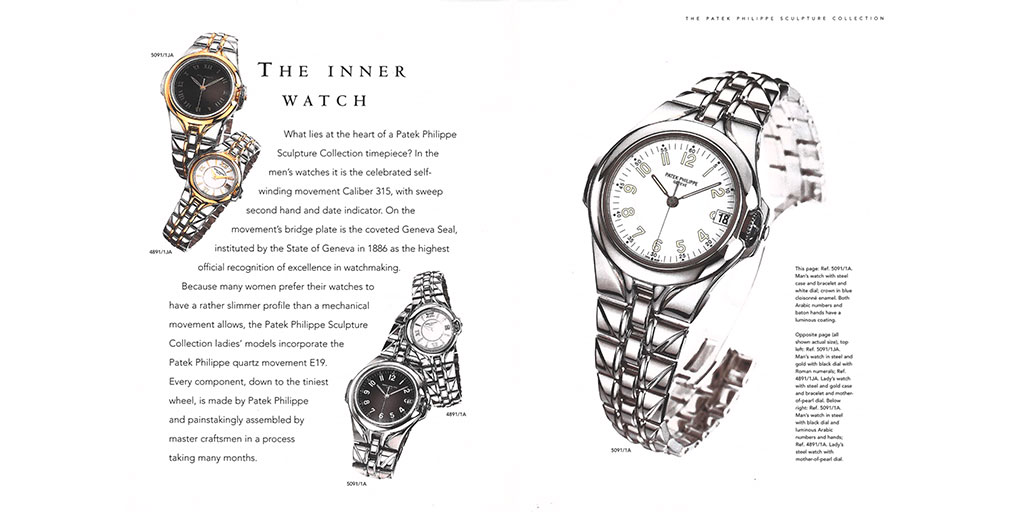
The Sculpture Collection
2,700 Sculpture watches were made in total. This is the approximate breakdown of the collection. Between 50-300 models were made in each version, exact numbers of production not publicly know.
Ref. 5090J Men’s Gold Strap Model with Black Dial
Ref. 5090J Men’s Gold Strap Model with Guilloche ‘Brick’ Dial
Ref. 5091/1A Men’s Steel Bracelet Model with Black Lume Dial
Ref. 5091/1A Men’s Steel Bracelet Model with White Lume Dial
Ref. 5091/1JA Men’s Steel and Gold Two-Tone Bracelet Model
Ref. 5091/1 Men’s Gold Bracelet Model
Ref. Ref. 4890J Ladies Gold Strap Model
Ref. 4891/1JA Ladies Steel and Gold Two-Tone Bracelet Model
Ref. 4891/11A Ladies all Steel Bracelet Model
Ref. 4891/11JA Ladies Steel and Gold Two-Tone Diamond Bezel Model
Ref. 4891/10J Ladies Gold Diamond Bezel Bracelet Model
Ref. 4891/101J Ladies Gold Diamond Bezel and Diamond Bracelet Model
Conclusion
The Sculpture collection is a unique and surprising footnote in Patek Philippe’s history. On the surface, it was a false start into a new area of design (and distribution) for Patek Philippe as it sought to reinforce its identity in the late 20th century. However, a deeper look shows how the Sculpture collection was very much in line with the brand’s DNA and spirit of experimentation and respect for the local markets. Often dismissed today as simply the ‘Russian’ watch, the Sculpture deserves more research and attention. At almost 25 years old now, it is aging well for the modern wrist and is a watch finally deserving of proper attention. It was a fearless design in the ‘Genta-esque’ design language with a bit of a Russian twist. It was ahead of its time and no doubt inspired other designers in the future – look at the Cartier Balon Bleu that was launched almost a decade after we saw the first Sculpture and you can see without a doubt the influence of the Sculpture on the design language of the early 21st century. After all, this quote from Mark Twain seems to sum up modern watch design in the most elegant way:
“There is no such thing as a new idea. It is impossible. We simply take a lot of old ideas and put them into a sort of mental kaleidoscope. We give them a turn and they make new and curious combinations. We keep on turning and making new combinations indefinitely; but they are the same old pieces of colored glass that have been in use through all the ages.”
October 2023



